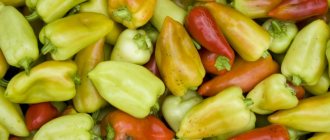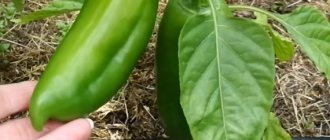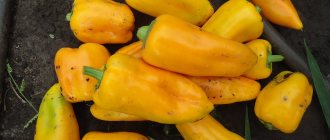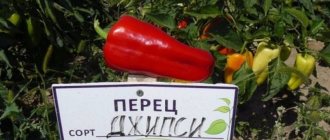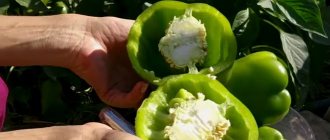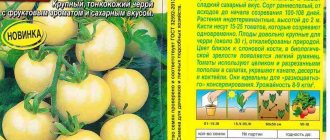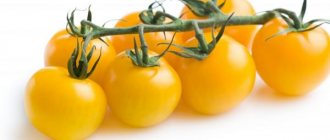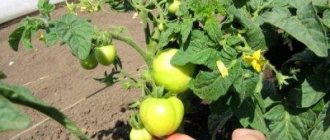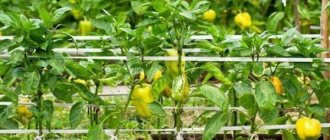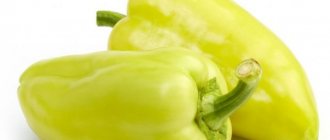Description and characteristics of the variety
Red Shovel is an early ripening variety, ripening in 100–110 days from emergence. It is suitable for cultivation both in greenhouses and in open areas. Pepper bushes are compact, not too branched, but quite tall (up to 80 cm), due to which they do not tolerate strong winds and require support during fruiting. The shoots are thin, with large leaves at the top. The harvest is formed in the lower part of the bush. About 15 large fruits can ripen on one plant at the same time, which is 5-6 kg per 1 m² - this is a good yield for sweet peppers.
Did you know? In terms of vitamin A content, red peppers are superior to carrots, and they contain more vitamin C than citrus fruits. At the same time, the calorie content of the fresh product is only 27 kcal per 100 g.
The peppers themselves, as the name implies, are red, one-dimensional, large in size: the average weight of the fruit is 120–140 g with a length of 15–20 cm, but there are specimens over 150 g. The shape of the peppers really resembles a palm or a shovel - they are cone-shaped, elongated and flattened, which makes them ideally folded in a jar during preservation. The pulp is fleshy (wall thickness 6–8 mm), dense, but juicy, with a pronounced sweetish taste and a pleasant peppery aroma. The fruits are universal in use: suitable for any preparation and consumption in their natural form.
Feeding seedlings
Done this way:
- the first - 13-14 days after planting;
- the second – 10-14 days after the first.
To do this, you need to make the following mixture: 0.5 g of nitrate, 3 g of superphosphate, 1 g of potassium fertilizer. All ingredients should be diluted in 1 liter of water. The second feeding is carried out using a double dose of fertilizer.
The plant will also benefit from a third feeding. The composition is the same as the second time, only 8 grams of potassium fertilizer should be taken.
Important! Chemical fertilizers can be easily replaced with organic ones. For example, nettle tincture in a ratio of 1:10 and the ash of any wood.
Advice! If the pepper seedlings are growing slowly, you should feed them with the following mixture: take the tea and pour it with three liters of boiling water. Let it sit for five days and water the plant.
Attention! When it comes to feeding, the most important thing is not to overdo it. Otherwise, weak sprouts may burn.
Also, if all the rules of growing are followed, the seedlings will be healthy and strong without any additional feeding.
Pros and cons of the variety
- Gardeners speak very highly of the Red Shovel variety, highlighting its following positive qualities:
- early ripening;
- attractive presentation of the fruit (large size, shape, bright skin color);
- good preservation of fruits and ability to be transported;
- delicate aroma and excellent taste;
- high productivity;
- universal use in cooking;
- unpretentiousness and disease resistance;
- simplicity of agricultural technology, allowing even novice gardeners to grow peppers.
The variety does not have any significant disadvantages, except that the bushes need to be shaped and tied up, otherwise the shoots may break under the weight of the harvest.
Find out how to speed up the ripening process of peppers.
Cultivation technology to obtain good yields
The variety has a long growing season, so it is grown mainly in seedlings. Before planting seedlings, they are grown for an average of two months. When the budding phase begins, they are planted in well-prepared soil. It may not be entirely fertile, provided that it is additionally fertilized. Optimally, it is recommended to plant seedlings in fertile soil with good water conditions. The timing of planting seedlings is the same as for the “Red Bull” variety, namely the end of February - the beginning of March. The seedlings themselves are planted closer to summer. In a greenhouse, planting can take place in May, and in the ground outside in early June. When planting, ensure abundant watering. This procedure will help the plant adapt more easily and begin intensive growth.
Advantages of the seedling method of growing
- Increased seed germination
- Leveling out adverse weather conditions
- Saving land area when sowing
- Regulating the timing of harvesting (depending on the timing of sowing)
Planting and growing peppers
Red spade, like all sweet pepper varieties, has a long growing season, so it is recommended to grow it as seedlings for open ground. Seeds are sown approximately 2–2.5 months before planting in the garden. Therefore, in order to have grown planting material by mid-May, sowing must be done at the end of February or beginning of March. The process of growing seedlings itself consists of several stages.
Seed preparation
Any seeds, either your own or purchased, must be prepared and tested for germination before sowing, since there are always certain risks.
This preparation includes the following activities:
- Disinfection of material . It should be placed in a solution of potassium permanganate for 30 minutes, then removed and dried. At this stage, the quality of the seeds is checked: the full ones settle to the bottom, and the empty ones, unsuitable for planting, float to the surface.
- Hardening . The dried seeds are kept in the refrigerator for 10–12 hours. This will make future seedlings more resistant to cold and temperature changes.
- Germination . In 1 layer, the seeds are laid out on a damp cloth (gauze), covered and placed in a warm place. All the time, until the sprouts appear, it is necessary to maintain humidity. You can moisten the fabric with water or a stimulating solution of “Epin”, “Kornevin”, “Heteroauxin”.
The seeds hatch in 3–5 days.
After this, they can be planted in the substrate. Read more about what to plant after pepper next year.
Selection of containers
It is better to plant peppers immediately in separate containers. These can be cups, cassettes, peat pots or tablets. The advantage of separate containers is that the plants will not need picking, which leads to damage to the roots and stunted growth. You can also use a shared box or container. In this case, the seeds are planted in nests of 2-3 pieces at a distance of at least 4 cm from each other.
Land preparation
For seedlings, it is more convenient to use a ready-made substrate purchased in a store. It already contains the necessary elements and does not require disinfection. All that remains is to pour it into cups and sow the seeds. If desired, it can be mixed in half with garden soil so that after transplanting into the garden the seedlings will adapt faster. But ordinary soil must be thoroughly disinfected. The same should be done with the substrate prepared with your own hands.
We recommend that you learn how to grow peppers on the balcony.
You can make your own soil mixture from 2 parts humus or leaf compost, 1 part sand and 1 part garden soil with the addition of 1-2 tbsp. l. ash. All components must be mixed and thoroughly disinfected: pour boiling water over it, a solution of potassium permanganate, or bake in the oven at a temperature of +60...+80°C for an hour. When the substrate dries (cools), it is distributed into cups, moistened if necessary, after which the seeds are sown to a depth of 1.5 cm. Next, the containers are covered with film and placed in a warm place (+24...+26°C) until sprouts appear.
Features of caring for seedlings
With the appearance of the first shoots, the film is removed and the plants are moved closer to the sun. The ambient temperature at this stage should be lowered to +20...+23°C so that the sprouts do not stretch. Further care consists of periodic watering, careful loosening of the substrate and maintaining the temperature regime. It is impossible to overwater the sprouts, as overmoistening can cause fungal diseases, including blackleg - the most dangerous enemy of seedlings of nightshade crops. For normal development, pepper requires at least 12 hours of daylight, which must be provided artificially on cloudy days.
Important! Pepper seedlings do not tolerate drafts, so you should not open windows if they are standing on a windowsill. It must also be remembered that when the temperature drops to +12
°
C pepper growth slows down.
If a special substrate was used for sowing seeds, then it is not necessary to feed the seedlings before transplanting into the ground, except in cases where they grow too slowly. In the absence of fertilizers in the soil, fertilizing is carried out at intervals of 2–3 weeks. Fertilizers can be used both mineral and organic. Mineral fertilizer is prepared from superphosphate (3 g) with the addition of nitrate and potassium salt (1 g each), diluted in 1 liter of water.
When it comes to organic matter, peppers love ash, dried tea leaves, and green fertilizer from grass. Plants planted in a common container must be picked when 1–2 true leaves appear. They are seated in separate containers filled with the same substrate. 10–14 days before transplanting into the ground, seedlings are hardened in air, increasing the procedure time daily from 15 minutes to 2 hours. In recent days, it is recommended to leave the plants overnight.
Soil planting technology
Peppers are transplanted into the garden at the stage of formation of the first buds, which corresponds to approximately two months of age. Planting is carried out no earlier than the threat of spring night frosts has passed, and the earth has warmed up to a temperature of +12...+14°C. By the time of planting, the area should be dug up and saturated with organic fertilizers. 3–5 days before transplanting, the bed is disinfected with a solution of copper sulfate (1 tbsp/10 l of water).
Did you know? You cannot plant sweet peppers next to hot varieties. Plants cross-pollinate, which changes the taste of the fruit
-
sweet peppers become bitter and tasteless.
You can spill boiling water or potassium permanganate on the soil, but on large areas it is still better to use fungicides that destroy pathogenic and fungal flora. Seedlings are planted in holes dug at a distance of 40 cm from each other and 50–60 cm between rows. With this scheme, 4 plants are placed per 1 m². The depth of the holes should be such that when planting, the root collar of the plant is flush with the surface.
Pour 1 tbsp into each well. l. complex mineral fertilizer (superphosphate is suitable), mix it with soil, then pour in warm water. When the moisture is absorbed, place a seedling in the center of the hole and carefully cover the roots, lightly compacting the soil. It is recommended to plant on a cloudy day or in the evening to prevent leaf scorch. If the climate in the region is unstable, then for some time at night the plants can be covered with cut plastic bottles and opened during the day.
Sowing process
Before sowing, you need to disinfect the soil. This can be done by watering it with a weak solution of potassium permanganate. Then place the sprouted seeds in pre-made grooves at a distance of about 2 cm. Carefully cover them with a thick layer of soil and cover with film. Next, you should place the box in a warm place until shoots emerge. This will happen in about a week. Next, you need to remove the film and add lighting using a special lamp. The temperature must be maintained at 20-25 degrees.
Important! If the temperature drops below 12 degrees, the seedlings will slow down their growth. This applies even to adult plants.
Diseases and pests
Among other pepper varieties, Red Shovel is considered the most disease-resistant. Even in rainy summers, fruits are rarely affected by rot, fusarium, late blight and other fungal infections. Problems can only arise in neglected beds, so it is important to regularly remove weeds and carry out preventive treatment of bushes.
Learn how to get rid of slugs, caterpillars and spider mites on peppers.
To do this, it is advisable to use folk remedies or biological products, since chemicals accumulate in fruits. Pests living in the ground, for example, wireworms, can be gotten rid of by disinfection and digging up the soil before planting, but it is very difficult to protect bushes from slugs, aphids and spider mites.
If slugs appear in the garden bed, sprinkle the soil with hot pepper or ash. Garlic or wormwood tincture helps get rid of spider mites, and a solution of ash or tobacco dust (dissolve 1 cup in a bucket of hot water) is effective against aphids. If, despite all the measures taken, the insect population has increased, the use of insecticides such as “Karbofos”, “Aktofit”, “Fitohelp” will be required.
How to properly care for plants
When caring, pay attention to the color of the plant. If the leaves are pale in color or have bright spots, then there is likely a soil fertility problem. This appearance of the plant indicates a lack of microelements absorbed from the soil. In this case, it is necessary to resort to the help of microfertilizers.
Read also: The benefits and harms of torpedo melon, collective farmer, Dalmatian, Good habits
To obtain high yields and the formation of good fruits, additional fertilizing should be carried out. They represent the introduction of special solutions and fertilizers. This can be potassium sulfate, superphosphate solution and others.
Let's sum it up
The variety performs well with a competent approach to its cultivation. Pay attention to the planting dates. Adjust your care methods depending on existing conditions. If you have fertile soil and do not set yourself the goal of obtaining very high yields, then you can not abuse fertilizing and additional fertilizing. In any case, stick to the technology and don't be afraid to deviate from it depending on your goals.
Valentin Fedorovich
Excellent variety. The fruits are so large that we even had to prop up the plants. I advise you to pay as much attention as possible during the period of active growth. A reverent attitude during this phase of development is a guarantee of a good harvest!
Nastasya
My husband insisted that one bed on our plot be sown with this variety. At first I thought that it wouldn’t take root, either the soil was not right or even worse the night frosts would strike, but that was not the case. The plants endured all the hardships and produced simply excellent red peppers. It was so amazing that I didn’t even want to pick it. This is my funny story.
Tamara Petrovna
Easy to care for and very tasty on the table. A good snack, by the way (laughs). I have already studied many recipes using this sweet red pepper and I don’t plan to stop. The pepper is quite large; I collected two to one and a half kilograms from several bushes. I think I will plant a lot more next year.
Reviews from gardeners
Tatyana from Voronezh was dissatisfied with the experience of growing Golden Lapt. In her review, she said: TM Prestige seeds showed poor germination. The pepper itself was late in bearing fruit and turned out to be low-yielding (3-4 fruits per bush). At the same time, a branded pack of seeds is relatively expensive. Elena (Ryazan region) grew the same variety from TM SibSad material. In her photo there is a huge fruit, beautiful outside and in cross-section, so the summer resident is pleased with the result of her work.
Judging by the reviews, Zolotoy Lapot pepper is not the most popular variety. The characteristics of amateur gardeners differ for the worse from those of the originator and manufacturers.
Picking
When 2-3 true leaves are formed on the plants, picking is carried out. Its goal is to give the sprouts a large area for development, while removing all weak and small sprouts. Since peppers really don’t like being touched in vain, replanting should be done very carefully so as not to damage the roots. You need to plant one Red Spade seedling in one cup. You should not bury the pepper sprout; it is better to plant it flush with the roots, this will stimulate the plant to develop a strong root system.
